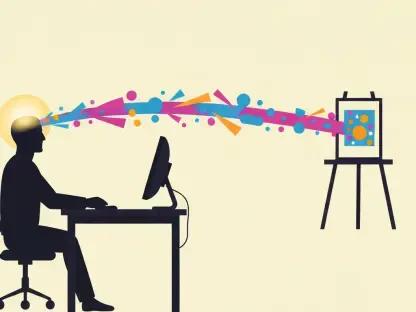Imagine a world where artificial intelligence can compose chart-topping hits in seconds, yet the very technology driving this innovation sparks a fierce legal battle that could redefine the music industry. This scenario is unfolding as major record labels, including Universal Music Group, Sony Music Entertainment, and Warner Music Group, have launched a high-stakes lawsuit against Suno, an AI music generation company, accusing it of copyright infringement through unauthorized data practices. This clash not only highlights the transformative potential of AI in music creation but also exposes deep tensions over intellectual property rights in a rapidly evolving digital landscape. The outcome of this case could shape the boundaries of creativity and technology for years to come, raising critical questions about how innovation can coexist with the protection of original works.
The AI Music Industry: An Overview
The AI music industry stands at the forefront of technological disruption, experiencing explosive growth as it reshapes how music is created, consumed, and distributed. With tools that can generate compositions, mimic styles, and even produce full tracks, this sector has become a pivotal intersection of music and technology, drawing interest from artists, producers, and tech giants alike. Its significance lies in democratizing access to music production, enabling individuals without traditional skills to craft professional-grade content, while also posing new challenges to established norms around ownership and creativity.
Key segments within this space include generative AI platforms like Suno, which allow users to create music from simple prompts, alongside other innovators pushing boundaries in sound design and personalization. Major players such as Universal Music Group, Sony Music Entertainment, and Warner Music Group dominate the traditional music landscape, often collaborating with or challenging AI startups to protect their vast catalogs. The Recording Industry Association of America (RIAA) plays a crucial role in advocating for these labels, ensuring that intellectual property rights remain a priority amid rapid technological advancements.
As AI tools become more sophisticated, copyright and intellectual property regulations are emerging as central forces shaping the industry’s trajectory. Governments and industry bodies are grappling with how to apply existing laws to novel technologies, while disputes like the one involving Suno underscore the urgent need for clear guidelines. The balance between fostering innovation and safeguarding creators’ rights is delicate, and the resolution of current legal battles will likely set precedents that influence market dynamics and policy for the foreseeable future.
Current Trends and Market Dynamics in AI Music
Emerging Trends and Technological Shifts
The AI music industry is witnessing a surge in generative AI technologies that can produce original compositions with minimal human input, revolutionizing creative processes. Practices such as stream-ripping, where audio content is allegedly extracted from platforms like YouTube to train AI models, have sparked controversy due to ethical and legal concerns. This trend reflects a broader shift toward leveraging vast online datasets, often without explicit permission, to fuel algorithmic innovation.
Consumer behavior is also evolving, with a growing appetite for AI-generated content driven by its accessibility and novelty. Platforms that lower the barrier to music creation are attracting hobbyists and professionals alike, fueling demand for user-friendly tools that can churn out personalized tracks. However, this enthusiasm is tempered by debates over whether such content diminishes the value of human artistry or simply augments it.
Opportunities for innovation abound, from enhancing collaboration between AI and human creators to developing new genres unique to machine-generated sounds. Yet, ethical dilemmas persist, particularly around data sourcing and ensuring fair compensation for original artists whose works may be indirectly used. These concerns highlight the need for transparent practices and industry standards to address potential exploitation while nurturing technological progress.
Market Performance and Growth Projections
The market for AI music technologies is expanding rapidly, with current estimates valuing the sector in the hundreds of millions, driven by increasing adoption among independent artists and major studios. Investment in AI startups has surged over recent years, with venture capital flowing into companies promising to redefine music production. Performance indicators, such as the rising number of tracks created using AI tools, suggest a robust upward trajectory for user engagement.
Looking ahead from this year to 2027, analysts predict significant growth as AI becomes more integrated into mainstream music workflows, potentially doubling the market size if legal and ethical hurdles are navigated successfully. Adoption rates among producers are climbing, with many incorporating AI for tasks like mixing, mastering, and even ideation, signaling a shift in how creative roles are defined.
However, legal outcomes, such as the ongoing lawsuit against Suno, could either accelerate this expansion by clarifying fair use boundaries or constrain it by imposing strict licensing requirements. A restrictive ruling might dampen investment in smaller firms unable to afford compliance costs, while a favorable decision for AI companies could spur innovation. These uncertainties underscore the intertwined nature of market performance and regulatory developments in shaping the industry’s future.
Challenges in AI Music and Copyright Disputes
The AI music industry faces formidable challenges, with copyright infringement allegations against companies like Suno taking center stage in the debate over data usage. Accusations of using copyrighted sound recordings without authorization to train AI models have ignited tensions between technology firms and traditional music stakeholders. This legal friction threatens to stifle smaller players who lack the resources to navigate complex intellectual property landscapes.
Technological hurdles also loom large, particularly in ensuring ethical data sourcing for AI training. The practice of stream-ripping, alleged in the Suno case, raises questions about bypassing digital protections, potentially violating laws like the Digital Millennium Copyright Act (DMCA). Beyond legal risks, market-driven issues such as intense competition between nimble startups and established tech giants create uneven playing fields, where innovation can be overshadowed by financial clout.
Potential solutions include developing licensing agreements that allow AI firms to use copyrighted material legally while compensating rights holders. Another avenue is the creation of “clean” AI models trained exclusively on authorized or public domain data, reducing legal exposure. Addressing these challenges requires collaboration across sectors to establish frameworks that protect intellectual property without curbing the creative potential of AI tools, a balance that remains elusive amid ongoing disputes.
Regulatory Landscape and Legal Battles
The regulatory framework governing AI music is rooted in U.S. copyright law, with the fair use doctrine and DMCA provisions serving as key battlegrounds in disputes like the one involving Suno. These laws were designed for a pre-AI era, leaving courts to interpret their application to modern technologies, particularly around the use of copyrighted material in training datasets. This legal ambiguity creates uncertainty for developers and rights holders alike.
The Suno lawsuit, backed by the RIAA, stands as a critical test case for determining whether training AI on copyrighted content without permission qualifies as fair use. Labels argue that such practices constitute infringement, while Suno contends that the transformative nature of its outputs and the non-public training process align with legal exemptions. The ruling could redefine how fair use is understood in the context of generative technologies, setting a benchmark for future cases.
Compliance challenges are compounded by the potential for this case to influence broader AI governance legislation. A decision favoring strict copyright enforcement might prompt lawmakers to introduce tighter controls on data acquisition, impacting industry practices globally. Conversely, a broader interpretation of fair use could encourage innovation but risk eroding protections for creators. Monitoring these legal developments is essential for understanding how regulatory shifts will reshape the intersection of AI and intellectual property.
Future Outlook for AI Music and Intellectual Property
The trajectory of the AI music industry hinges on the resolution of legal battles like the Suno case, with potential outcomes ranging from restrictive licensing mandates to expanded fair use protections. A ruling against Suno could force companies to secure costly agreements with rights holders, reshaping business models and possibly consolidating market power among larger entities. Alternatively, a decision supporting AI developers might accelerate tool development but intensify calls for new safeguards to protect artists.
Emerging technologies, such as blockchain, offer promising avenues for tracking data usage and ensuring creators receive compensation for their works used in AI training. Market disruptors, including innovative licensing models, could bridge gaps between stakeholders by facilitating direct agreements between artists and tech firms. These advancements suggest a future where transparency and fairness underpin technological progress, though adoption remains in early stages.
Consumer preferences are also shifting, with growing acceptance of AI-generated content balanced against concerns over authenticity in music. Striking harmony between fostering innovation and preserving human creativity will be crucial, especially as global economic conditions and regulatory trends evolve. Judicial precedents set in the coming years will likely influence how these dynamics play out, guiding the industry toward sustainable growth or heightened conflict depending on the balance achieved.
Conclusion and Key Takeaways
Reflecting on the intense legal scrutiny that defined the clash between major record labels and Suno, it becomes evident that the AI music industry stands at a crossroads. The allegations of copyright infringement through unauthorized data practices illuminate broader struggles over how technology and creativity can coexist. Each argument, from fair use defenses to DMCA violations, underscores the complexity of adapting old laws to new frontiers.
Moving forward, stakeholders need to prioritize collaborative solutions, such as establishing standardized licensing frameworks that ensure fair compensation without stifling innovation. AI developers are encouraged to invest in transparent data sourcing methods, while policymakers must consider legislation that addresses the unique challenges of generative technologies. Record labels, meanwhile, face the task of adapting to a landscape where AI tools are inevitable, seeking partnerships rather than solely litigation.
The path ahead demands vigilance and adaptability, with an emphasis on emerging tools like blockchain to track and reward creative contributions. By fostering dialogue across sectors, the industry can build a future where technological advancement amplifies human artistry rather than diminishes it. This balance remains the ultimate goal, guiding efforts to navigate uncharted legal and ethical terrain with clarity and purpose.









